Today's Thursday • 17 mins read
Ultimately, the best book on Stoicism for you will be the one that improves your life. These 10 books will show you how to apply the best Stoic principles to your daily life.
Stoicism is a centuries-old philosophy that remains popular today due to its practicality and relevance to modern life.
Today, it inspires many entrepreneurs, athletes, artists, members of the military, and honest, hard-working individuals. You don’t have to be a Stoic philosopher to use their helpful principles in your life.
You could read this: Stoicism For Beginners: 7 Quick Lessons.
Here are the ten best Stoicism books you might add to your reading list:
1. The Daily Stoic: 366 Meditations on Wisdom, Perseverance, and the Art of Living
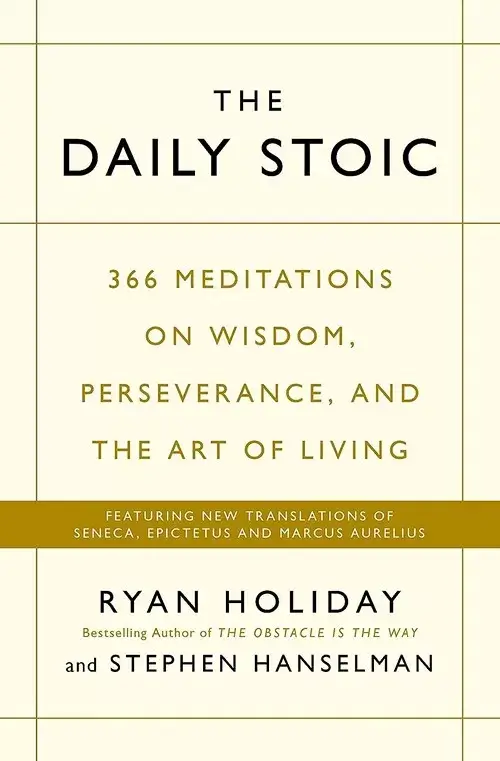
I recommend The Daily Stoic: 366 Meditations on Wisdom, Perseverance, and the Art of Living for anyone interested in Stoicism. The daily meditations in this book modernize the teachings of Stoic philosophers like Seneca, Epictetus, and Marcus Aurelius.
Each entry for the date of the year features a Stoic quote followed by a simple explanation. See below, from my Kindle:
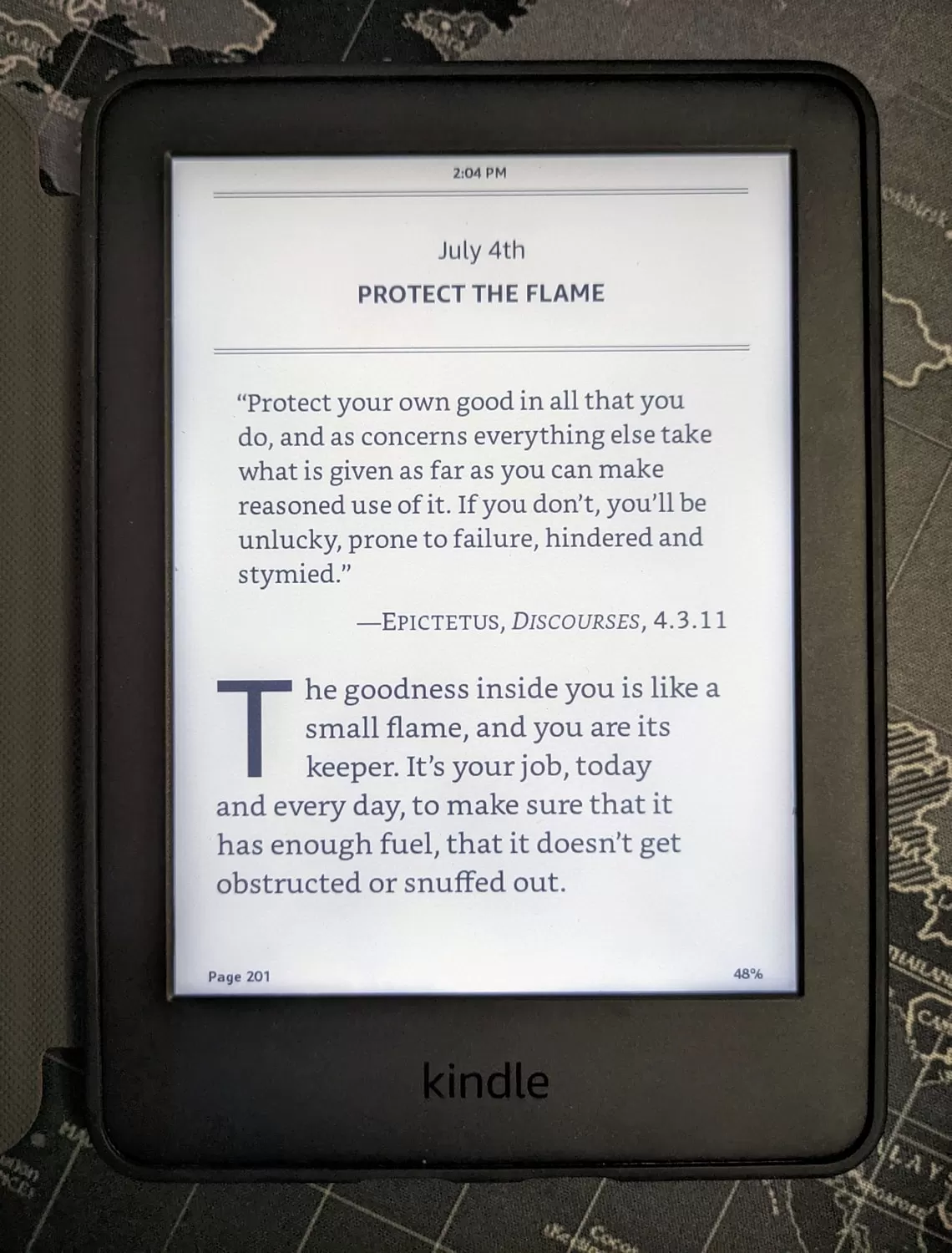
You get practical advice for living a happier and fulfilling life, handling challenges, and achieving the duty of self-discipline. Some ideas may seem repetitive, but this is a good thing, as it reinforces key Stoic principles.
The Daily Stoic is a handy reference for anyone bringing Stoicism into their daily life. It’s perfect to read in bytes, and you could keep a copy on your desk to read that day’s page, and get some of its timeless insights.
2. How To Be A Stoic: Ancient Wisdom for Modern Living
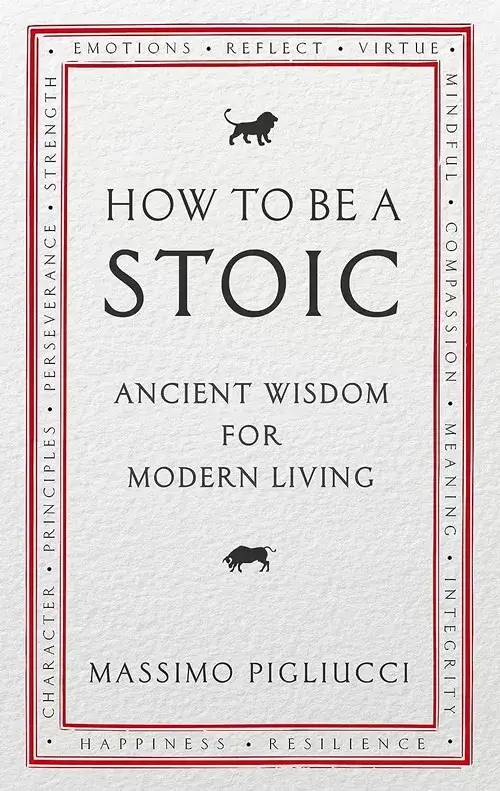
If you want a short, 230-page guide to Stoicism as a pragmatic way to navigate life’s challenges, then Massimo Pigliucci’s “How To Be A Stoic: Ancient Wisdom for Modern Living” is an excellent choice.
- You’ll appreciate the author’s clear and concise explanation of the complex ideas of Stoicism.
- This book is for anyone looking for ways to improve their lives through Stoic philosophy.
- The practical advice in the book is helpful, and I have applied them to my own life.
Massimo Pigliucci is a philosopher and teaching professor. He explains Stoicism and advises on how to apply it to modern life.
The book is divided into three parts:
- The first part introduces The Discipline of Desire (explaining what things we control and what is proper to want in life).
- The second part discusses The Discipline of Action (explaining how we should behave in this world and what our role models do).
- The third part provides The Discipline of Assent (explaining Stoic ideas on death, self-harm, anger, anxiety, loneliness, love, and friendship).
Pigliucci uses ancient Stoic principles to make modern relevance, showing readers how to decide what’s within their control and what’s not.
Here are some of the Stoic exercises that he recommends:
- Gratitude: Stoics practice gratitude by taking time each day to reflect on the things they are grateful for. This can be done by keeping a gratitude journal or simply taking a few minutes each day to think about the things in your life that you are thankful for.
- Meditation: Stoics meditate by focusing their attention on the present moment and letting go of negative thoughts and emotions. This can be done by sitting in a quiet place and focusing on your breath, or by using a guided meditation.
- Visualization: Stoics visualize themselves successfully completing difficult tasks. This can be a helpful way to build confidence and motivation.
The book’s strength lies in its practical approach, offering 12 spiritual exercises that Pigliucci extracts from Epictetus’s Enchiridion:
- Examine your impressions.
- Remind yourself of the impermanence of things.
- The reserve clause. “Whenever planning an action, mentally rehearse what the plan entails.”
- Ask yourself: “How can I use virtue here and now?”
- Pause and take a deep breath. “Remember, it is not enough to be hit or insulted to be harmed, you must believe that you are being harmed.”
- Other-ize. Ask yourself: “What makes us think that we are the universe’s special darlings, or that we ought to be?”
- Speak little and well. Let silence be your goal for the most part; say only what is necessary, and be brief about it.
- Choose your company well.
- Respond to insults with humor.
- Don’t speak too much about yourself.
- Speak without judging.
- Reflect on your day. “Admit not sleep into your tender eyelids till you have reckoned up each deed of the day—How have I erred, what done or left undone?”
“It’s not events that upset us but our judgments about events.” — Epictetus
Overall, my view is this is a great book for anyone who wants to read an engaging modern interpretation of the Stoic master Epictetus’ work. You will feel as if the professor was teaching you in an interesting class.
3. How to Think Like A Roman Emperor: The Stoic Philosophy of Marcus Aurelius
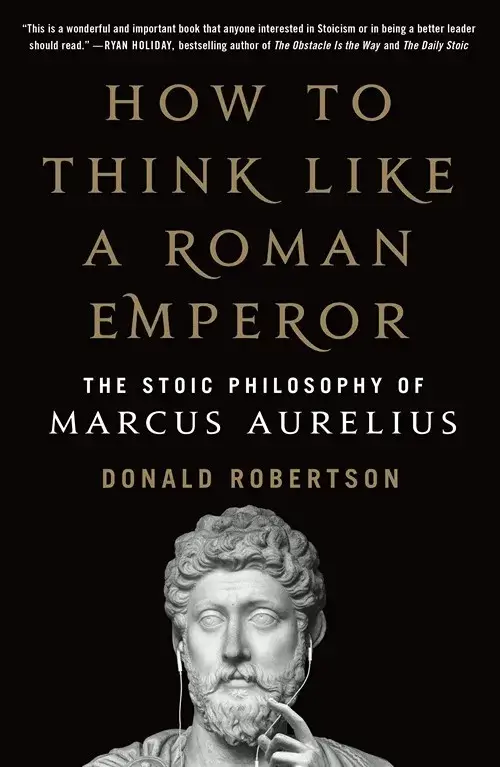
“How to Think Like a Roman Emperor: The Stoic Philosophy of Marcus Aurelius” by Donald J. Robertson is an excellent exploration of Stoicism as practiced by the last famous Stoic: Marcus Aurelius, Roman Emperor.
The book how Marcus Aurelius used Stoic principles to live his own life, and govern the Roman Empire during a time of great instability and crisis.
Here’s a chapter-wise, short summary to pique your interest in buying the book:
- Chapter 1. The dead emperor: Marcus is in Vindobona (Vienna), nearing his death from a disease. He rues how people “sneer at his vision of an empire that makes the freedom of its citizens its highest goal.” Robertson tells the shipwreck story that led to the founding of Stoicism by Zeno.
- Chapter 2. The most truthful child in Rome: Marcus’ childhood was focused on learning philosophy. He trains in practical wisdom, speaking skills, and mental resilience. He internalizes the core values of Stoicism. Robertson gives us this tool: To ask ourselves in tough times, “What would Marcus do?”
- Chapter 3. Contemplating the sage: Marcus learns to listen patiently, speak wisely, and stay pure in thought. He says we should be able to answer truthfully if someone asks, “What’s going on in your mind right now?” He also recommends starting and ending the day with self-reflection.
- Chapter 4. The choice of Hercules: Pleasure is not happiness; true joy comes from virtue in actions. We learn how to conquer unhealthy desires, be rationally happy, and practice amor fati, or love of our fate.
- Chapter 5. Grasping the nettle: Marcus was frail but astoundingly resilient. Our judgments affect how we feel pain, so to tolerate pain, we should see it without judging it (“cognitive distancing”). Our disabilities should not stop us from being virtuous. We must avoid overwhelming our minds by worrying about the future or ruminating about the past.
- Chapter 6. The inner citadel and war of many nations: When we’re indifferent to results, we find that the obstacle is the way. We can prepare for adversities by “envisaging feared catastrophes as if they were really happening.” We learn how to reduce anxiety through emotional habituation.
- Chapter 7. Temporary madness: Anger is but temporary madness, and does more harm to us than to the person with whom we’re angry. We can conquer anger by accepting other people’s mistakes and being kind to our enemies.
- Chapter 8. Death and view from above: Marcus meditates on life, death, and philosophy during a near-death hallucination. I feel that this meditation (written in first person as Marcus Aurelius) is the most beautiful part of the book.
“Life is warfare and a sojourn in a foreign land. Our reputation after life is nothing but oblivion. What is it then that will guide man? One thing alone: philosophy, the love of wisdom.” — Marcus Aurelius, Meditations 2.17
Robertson presents Stoicism for a modern, general reader. Delightfully, the book can stand on its own as a self-help book, even for those who don’t yet want to adopt Stoicism into their lives.
4. Meditations by Marcus Aurelius: For The Contemporary Reader
“Meditations” is a great work of philosophy for beginners and advanced Stoics. It was written by the Roman Emperor Marcus Aurelius (121-180 CE) — by far the most powerful man in the world.
Despite being written over 2,000 years ago, the writing is clear and concise, making it easy and relevant for modern readers.
The three most notable translations of Meditations are:
i.Meditations of Marcus Aurelius: A New Translation – Gregory Hays

The English translation by Gregory Hays is widely considered to be the best. His modern style makes these reflections on life, civilization, and nature relevant and easy to understand.
Overall, I’d highly recommend Meditations by Gregory Hays to anyone who wants to gain a deeper understanding of Stoic philosophy and look inside the mind of The Philosopher-King.
ii. Meditations of Marcus Aurelius: Annotated – Robin Waterfield
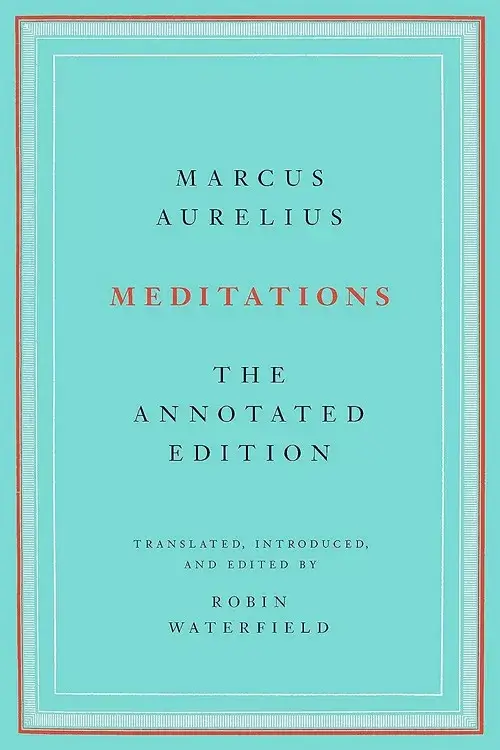
This book is an annotated edition from world-renowned classics expert Robin Waterfield, who offers a definitive translation of this much-beloved text, with copious notes and footnotes.
iii. Meditations of Marcus Aurelius: Selected Correspondence – Robin Hard and Christopher Gill
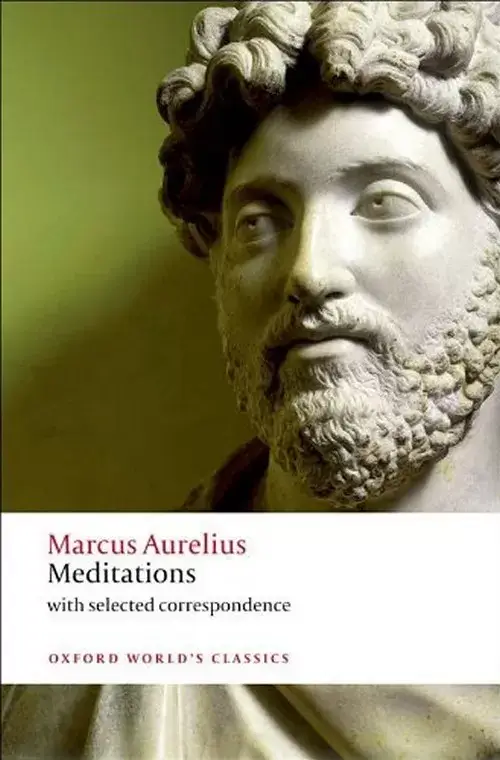
Robin Hard is a German classicist who has specialized in the study of Greek philosophy.
His translation of Meditations is considered one of the most accurate and readable translations of the work. He avoids jargon and technical language to capture the spirit of Marcus Aurelius’ writing while making the book readable and engaging.
- “Meditations” offers a deep and insightful look into the philosophy of a Roman Emperor.
- Written as a private journal, it gives us bold insights into life/death, morality, and human nature.
- Marcus Aurelius, the last great Stoic of antiquity, explores Stoicism from the position of a powerful king struggling like a human being.
Marcus draws from his own ideas and those of Socrates, Epicurus, and Stoicism to show us how a great leader practices philosophy in daily life.
Surprisingly, this private journal of thoughts was never meant to be published, as Marcus wanted it destroyed at his death.
However, it survived and has never gone out of print since it was first published in the 10th century. The churchman Arethas, who found it, wrote to a friend,
“I have had for a while now a copy of the Emperor Marcus’s invaluable book. It was not only old but practically coming apart. . . . I have had it copied and can now pass it on to posterity in better shape.”.
The book is incredibly thought-provoking. His approach to philosophy is not just theoretical but practical and adaptive.
- Marcus Aurelius encourages readers to reflect on their own thoughts and behaviors and to strive for self-improvement. And be prepared to deal with “meddling, ungrateful, arrogant, dishonest, jealous, and surly” people.
- His emphasis on using every life situation as a chance to understand and practice philosophy, like objective judgment, unselfish action, and willing acceptance of external events (amor fati), is particularly inspiring.
- He notes that it is not shameful to ask for help when overwhelmed, a reminder that even the most powerful emperor is not immune to the trials and struggles of life.
Marcus’s writing strikes an extraordinary balance between image and idea. For example,
“Keep in mind how fast things pass by and are gone—those that are now, and those to come. Existence flows past us like a river: the “what” is in constant flux, the “why” has a thousand variations. Nothing is stable, not even what’s right here. The infinity of past and future gapes before us—a chasm whose depths we cannot see.”
— Marcus Aurelius, Meditations, 5.23
Marcus wrote in Koine Greek. The first English translation came out in 1634 by Meric Casaubon.
Marcus focuses on key attributes of human life – character, virtue, self-control, kindness, and memento mori. He reminds himself to stay focused on the present moment and that death is not to be feared when it comes to carrying out his worldly duties.
“You could leave life right now. Let that determine what you do and say and think.”
— Marcus Aurelius, Meditations, 2.11
5. A Guide to the Good Life: The Ancient Art of Stoic Joy
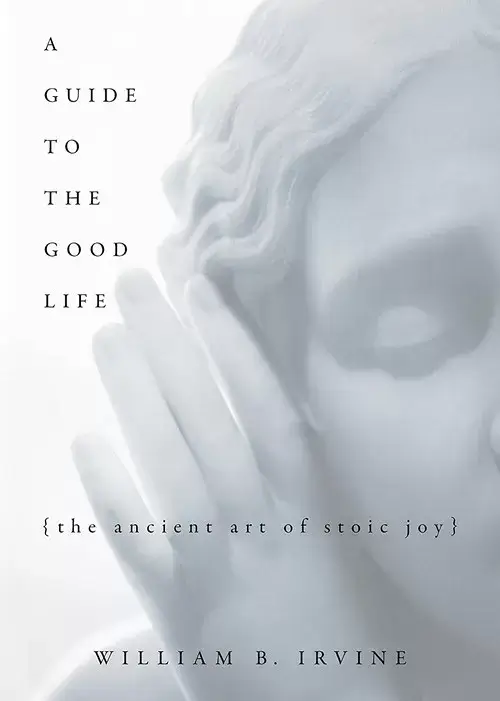
William Irvine’s A Guide to the Good Life: The Ancient Art of Stoic Joy is a hands-on guide that explores Stoicism from a personal and insightful standpoint. It shares modern examples for applying some of those ancient principles, giving us simple techniques to manage our desires, defeats, and negative emotions.
Irvine emphasizes understanding what we can control and accepting what we cannot, which leads to a more fulfilling life. He interprets the wisdom of four influential Roman Stoics: Epictetus, Seneca, Musonius Rufus, and Marcus Aurelius.
The book is divided into four sections:
- The first explores the origins of Stoicism.
- The second presents Stoic Psychological Techniques for fostering tranquility, notably “negative visualization or Premeditatio Malorum”.
- The third part provides “Stoic advice” on social relationships, handling insults, grief, anger, luxurious living, the pursuit of fame and fortune, aging, and death.
- The final part includes Irvine’s humorous reflections on his journey in practicing Stoicism.
Reading this book has helped me soften my anger toward difficult people. I now recognize that I cannot control their actions. So, instead, I’m better off appreciating the good in my life.
It’s an easy book to read, see my screenshot below:
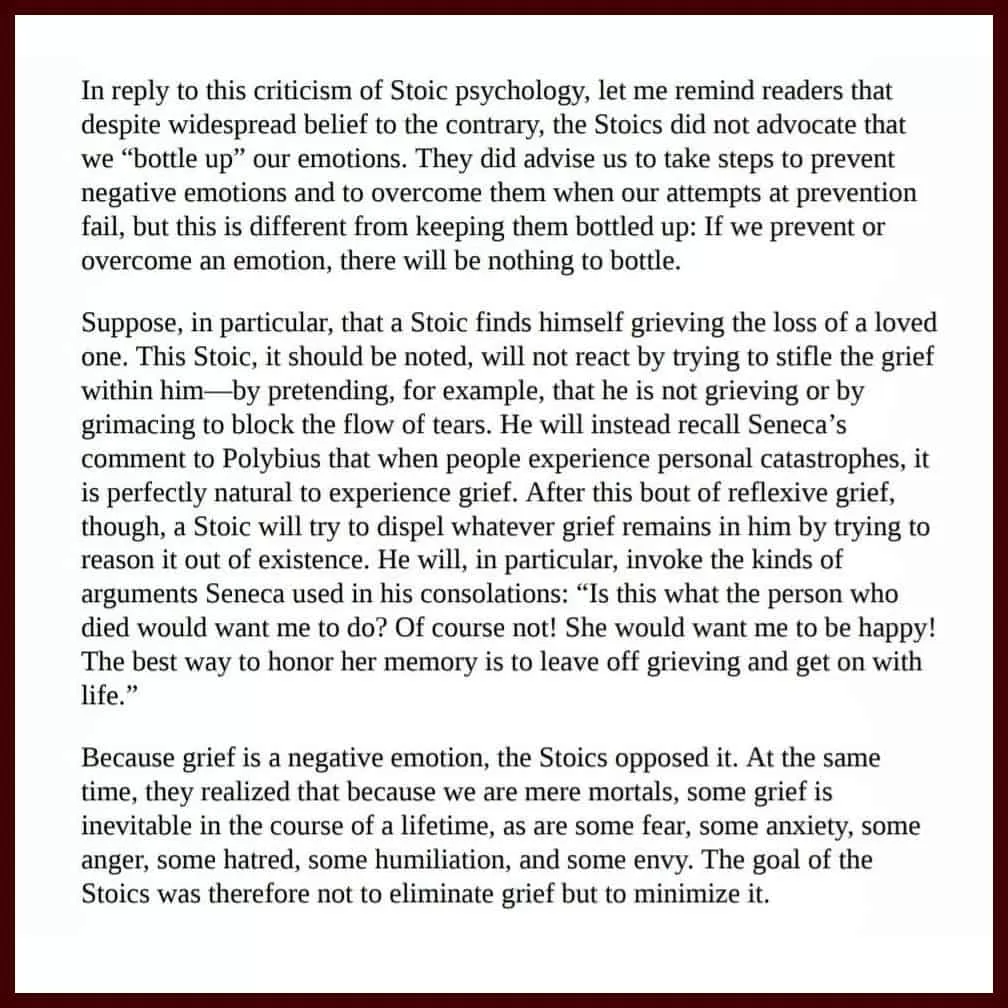
6. 365 Ways To Be More Stoic: A day-by-day guide to Practical Stoicism
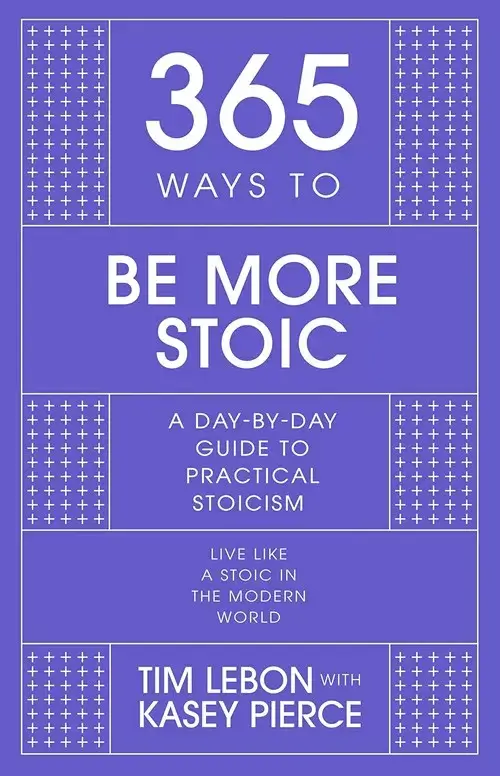
In 365 Ways to Be More Stoic, Tim Lebon and Kasey Pierce offer daily Stoic wisdom in a very digestible format. Stoic teachings and modern experiences come together to show us how to live happier, more purposeful lives.
Its page-long pieces of wisdom are an easy and handy resource for Stoicism enthusiasts. The book covers the four cardinal virtues (wisdom, courage, justice, and moderation) to guide readers on how to cope with adversity, manage anger, and reflect on life’s brevity.
The Stoic ideas come in engaging chunks, making it enjoyable to read. It’s your year-long resource filled with inspiring tools, stories, actions, and rituals to enrich your life with Stoic meaning. You’ll find prompts, concepts, challenges, quotes, examples, quizzes, and case studies here.
See below how Lebon & Pierce equip readers to absorb the Stoic wisdom of the day by giving out small, achievable daily practices to tackle frustration, adversity, and even mortality:
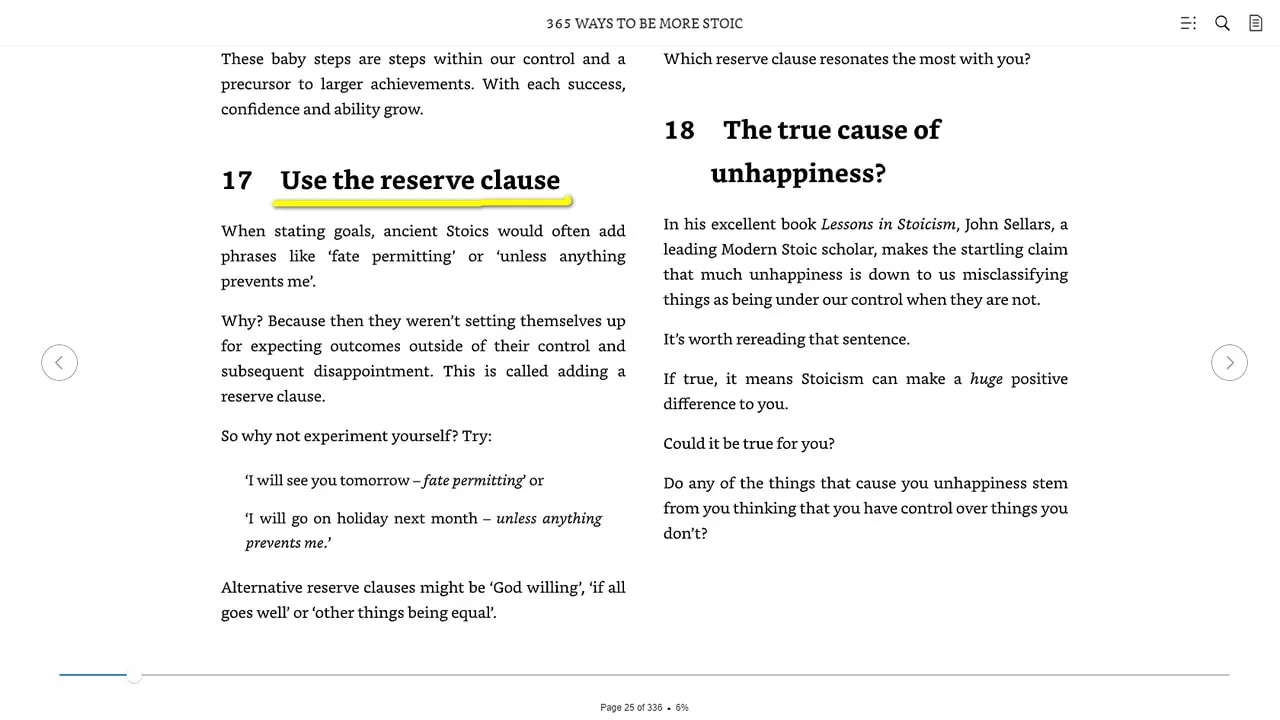
7. Journal Like A Stoic: A 90-Day Stoicism Program to Live with Greater Acceptance, Less Judgment, and Deeper Intentionality
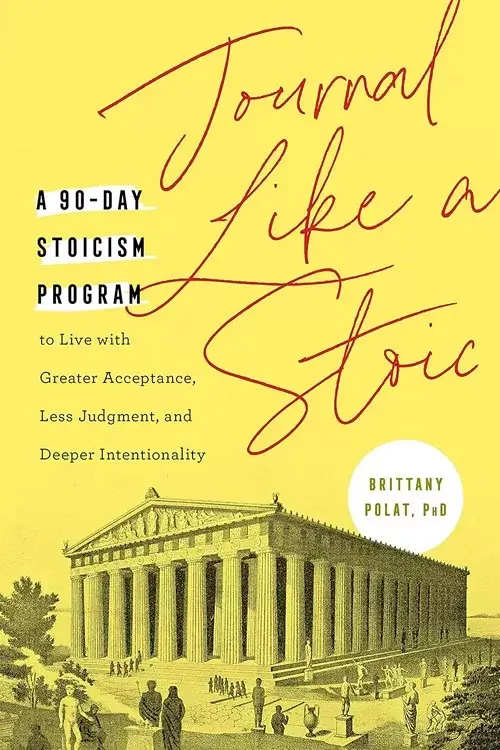
Journal Like a Stoic by Brittany Polat, PhD, is for anyone wanting to incorporate the Stoic way of journaling into their daily life. This is a concise and practical guide, and it comes with clear instructions.
You get a well-organized 90-day program. The incisive prompts encourage you to explore deep into your thoughts and behaviors. Each day’s prompts build on the previous ones, allowing for gradual reflection.
Of course, some readers may find the daily journaling commitment time-consuming or challenging to maintain. So, approach it with that in mind.
8. Letters from a Stoic: Seneca’s Moral Letters to Lucilius
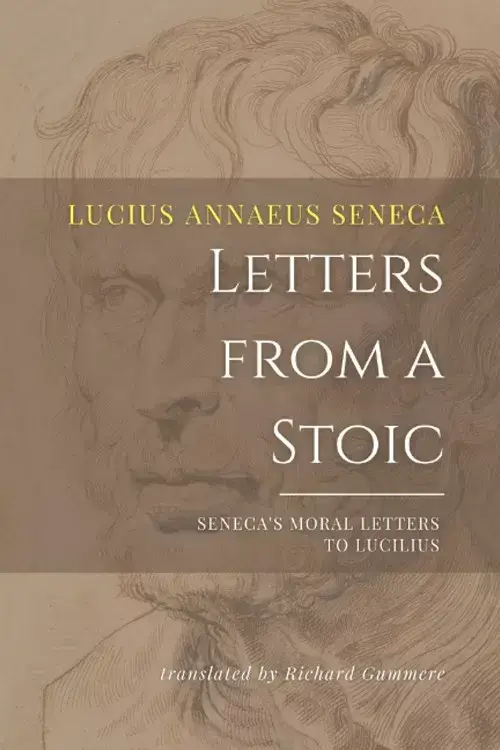
“Letters from a Stoic” is a collection of personal letters written by the Roman philosopher Seneca. Seneca’s letter-style essays to his friend Lucilius, the Governor of Sicily, are a cornerstone of Stoic philosophy.
Lucius Annaeus Seneca, known as Seneca the Younger (c. 4 BCE-65 CE), was a prominent figure in ancient Rome, skilled in rhetoric, grammar, and ethics. He is recognized for his practical approach to Stoicism as a means of self-improvement.
Seneca faced hostility from three Roman emperors. Caligula exiled him over a suspected affair. Claudius recalled him, only to exile him again. Agrippina later brought him back to tutor her son Nero, and he eventually became Nero’s chief advisor before Nero forced him to commit self-harm.
His letters provide practical advice on achieving a good life, avoiding corruption, and facing death without fear. Written in a conversational style, they reflect Stoic values of courage, self-control, and rationality. Seneca emphasizes the dignity of the individual mind while promoting a tolerant outlook.
Throughout, Seneca shares personal stories to support his insights, making Letters from a Stoic a timeless work that imparts practical wisdom for leading a good life.
9. The Practicing Stoic: A Philosophical User’s Manual
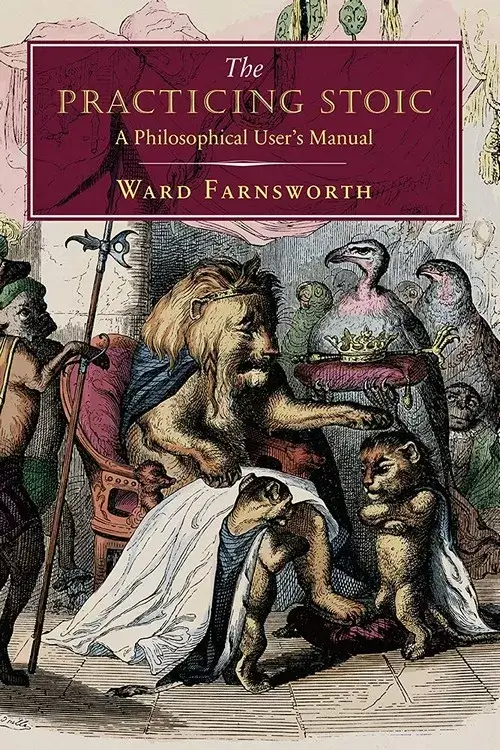
The Practicing Stoic: A Philosophical User’s Manual is for anyone seriously interested in Stoicism.
- Provides a comprehensive overview of Stoicism and its practical applications.
- Written in an accessible and engaging style that is easy to understand.
- Includes a wide range of quotes and examples from ancient Stoic philosophers.
The Practicing Stoic: A Philosophical User’s Manual is a must-read for anyone interested in Stoicism. The book provides a comprehensive overview of the philosophy, including its history, key concepts, and practical applications. The author writes in an accessible and engaging style that is easy to understand, even for those who are new to Stoicism.
One of the book’s greatest strengths is its use of quotes and examples from ancient Stoic philosophers. These passages help to illustrate the key concepts of Stoicism and provide readers with a deeper understanding of the philosophy. The author also includes helpful exercises and practical advice for applying Stoicism in everyday life.
However, some readers may find the book’s focus on philosophy and theory to be too abstract. The book could benefit from more concrete examples of how Stoicism can be applied in everyday life. Additionally, some readers may be disappointed by the lack of original content, as much of the book consists of quotes and passages from other Stoic works.
Overall, The Practicing Stoic: A Philosophical User’s Manual is a valuable resource for anyone looking to deepen their understanding of the philosophy and apply its principles in their own life.
10. The Little Book of Stoicism
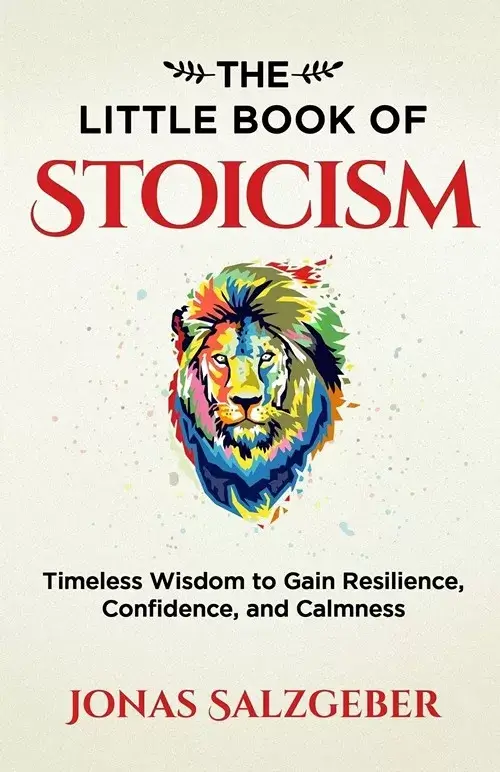
“The Little Book of Stoicism” is a helpful and accessible introduction to Stoic philosophy.
- Provides a clear and concise introduction to Stoicism for beginners
- Offers practical tips and exercises for applying Stoic philosophy to daily life
- Written in an accessible and engaging style
The author and editor are twin brothers, who do an impressive job of explaining the key concepts and principles of Stoicism to the casual reader.
You will find practical tips and exercises for applying Stoic philosophy to everyday life, such as journaling and negative visualization.
Keep in mind, this is a book for beginners. So if you’re already familiar with Stoicism, you may find it too basic. If you start with this book, you might buy more books about Stoicism that explain it better and in a more nuanced way.
Still, the exercises and tips are helpful for everyone.
Overall, I may suggest The Little Book of Stoicism as a great option for the casual reader who’s interested in learning about Stoic philosophy.

Honorable Mentions: 10 More Stoicism Books
Each book here is exceptional in its own right, justly ranked among the Amazon Best Sellers in Greek & Roman Philosophy:
- Mastering The Stoic Way Of Life – Andreas Athanas
- Stoicism for Inner Peace – Einzelgänger and Fleur Vaz
- 20 Short Stories To Build A Stoic Lifestyle – Cyrus Valen
- Stoicism Made Simple: Find Your Inner Peace – Terry Cole
- The Stoic’s Guide to Emotional Mastery – Winston Meskill
- Stoicism for Modern Times (3 books in 1) – Alexander Clarke
- Discipline Is Destiny: The Power of Self-Control – Ryan Holiday
- Breakfast with Seneca: A Stoic Guide to the Art of Living – David R. Fideler
- Stoicism: How to Use Stoic Philosophy to Find Inner Peace – Jason Hemlock
- Lives of the Stoics: The Art of Living – Ryan Holiday and Stephen Hanselman
Final Words
Seneca, a rich and powerful Roman senator and Stoic philosopher, wrote the book “On the Happy Life” around 58 AD. In it, he tells us that happiness is about living a worthy life.
So, as they pursue worthy lives, can Stoics be happy?
√ Please share it with someone if you found this helpful.
√ Also Read: 20 Best Stoicism Books For Beginners (5 of Them Free)
» You deserve happiness! Choosing therapy could be your best decision.
...
• Disclosure: Buying via our links earns us a small commission.

